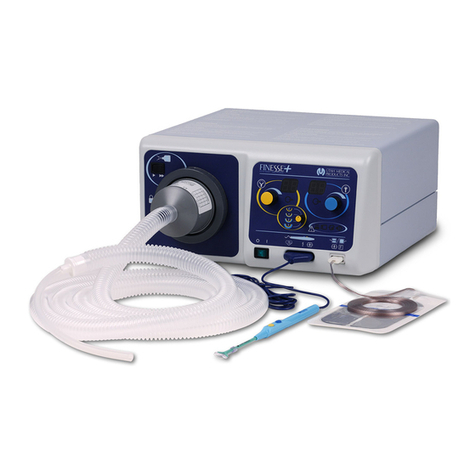the cutting electrodes in the tissue. These principles are dis-
cussed in the “Principles of Electrosurgery” section of the
Finesse®Operator's Manual.
As mentioned in the safety warnings of the operator's manual,
this knob should not be turned up to correct an apparent
power output deficiency without first verifying that all connec-
tions are in good order and the patient dispersive electrode is
still properly applied.
5. Coag Indicator Lamp. This blue lamp is illuminated whenever
coag voltage is applied to the active lead. Illumination of this
lamp is accompanied by an audio tone having a pitch lower
than the tone heard during a fault in the dispersive electrode
monitoring circuit but has a pitch higher than the tone heard
during operation in the cut mode.
6. Coag Output Control Knob and Indicator. This knob is used
to specify the output level desired for the intended coag oper-
ation. The adjacent digital readout indicates the output set-
ting.
Due to line voltage and thermal variations, it is normal for the
number displayed on the digital indicator to vary by one or
two digits while the control knob is stationary. While this vari-
ation truly reflects the relative output setting, it is of no clinical
significance and will not affect coagulation quality.
The coag mode display can be continuously adjusted between
"05" and "75". Smaller or finer electrodes require a lower set-
ting and larger electrodes will require a higher setting. Lower
settings on this knob may be used for desiccation coagulation.
The principles of coagulation by desiccation and fulguration
are explored in the “Principles of Electrosurgery” section of the
Finesse®Operator's Manual.
7. Patient Dispersive Electrode Receptacles. Three sets of dis-
persive pad receptacles are provided to accommodate the dis-
persive pad cable configurations that are commonly available.
The left-most socket pair is provided to take two redundant
leads out to a dispersive electrode. If either of these leads has
broken continuity, or if either lead is omitted, the red patient
alarm warning lamp in the center of the terminal block illumi-
nates and current from the generator is automatically shut off.
The center dispersive pad connector is a phone plug that
accommodates the phone plugs provided with many of the
available pads. Redundant leads are used, and the continuity
sensing circuit warns of a compromised dispersive electrode
connection.
The right-most rectangular socket is compatible with most of
the remainder of the available pads. Like the other two recep-
tacles, it accommodates dual-conductor cables.
8. Patient Alarm Indicator Lamp. This red lamp is illuminated
whenever the generator is disabled due to one of the following
conditions:
1) Incomplete redundant dispersive electrode connections
(accompanied by intermittent high-pitched alarm tone);
2) Simultaneous activation of both cut and coag modes
("cross-key") (accompanied by continuous high-pitched
alarm tone); or
3) Activation of the output safety circuit (accompanied by a
continuous high pitched audio tone).
The output safety circuit continuously monitors the output of
the generator and will disable the system when an unexpected
discrepancy between the displayed output setting and the out-
put power is detected. The main power switch must be tog-
gled off to clear this condition.
9. Monopolar Handswitch Receptacle. This connector consists
of three banana sockets which accommodate most of the
reusable and disposable hand-switching electrosurgical pens
that are available.
The left-most of the three sockets, marked with the "active
port" icon, accommodates a non-switching pen for monopolar
Finesse Service Manual
4





























